ThisiscontentfromElsevier'sDrugInformation
Epoetin Alfa
Learn more about Elsevier's Drug Information today! Get the drug data and decision support you need, including TRUE Daily Updates™ including every day including weekends and holidays.
General Dosing Information
NOTE: Epoetin alfa is designated an orphan drug by the FDA for this indication
50 to 100 units/kg/dose subcutaneously or IV 3 times weekly, initially. Monitor hemoglobin (Hgb) weekly until stable and then at least monthly (after initiation of therapy and each dose adjustment) and adjust dose based on Hgb. Do not increase the dose more frequently than every 4 weeks; decreases in dose can occur more frequently. Decrease or interrupt the dose if Hgb exceeds 10 g/dL. Use the lowest dose possible that will maintain a Hgb concentration sufficient to reduce the need for red blood cell transfusion. If response is not seen over a 12-week escalation period, increasing the dose further is unlikely to improve response and may increase risks; evaluate other causes of anemia and discontinue use if responsiveness does not improve.[30100] [45862] [63174]
50 units/kg/dose subcutaneously or IV 3 times weekly, initially. Monitor hemoglobin (Hgb) weekly until stable and then at least monthly (after initiation of therapy and each dose adjustment) and adjust dose based on Hgb. Do not increase the dose more frequently than every 4 weeks; decreases in dose can occur more frequently. Decrease or interrupt the dose if Hgb approaches or exceeds 12 g/dL. Use the lowest dose possible that will maintain a Hgb concentration sufficient to reduce the need for red blood cell transfusion. If response is not seen over a 12-week escalation period, increasing the dose further is unlikely to improve response and may increase risks; evaluate other causes of anemia and discontinue use if responsiveness does not improve.[30100] [45862] [63174]
50 to 100 units/kg/dose subcutaneously or IV 3 times weekly, initially. The IV route is recommended for individuals on hemodialysis. Monitor hemoglobin (Hgb) weekly until stable and then at least monthly (after initiation of therapy and each dose adjustment) and adjust dose based on Hgb. Do not increase the dose more frequently than every 4 weeks; decreases in dose can occur more frequently. Decrease or interrupt the dose if Hgb approaches or exceeds 11 g/dL. Use the lowest dose possible that will maintain a Hgb concentration sufficient to reduce the need for red blood cell transfusion. If response is not seen over a 12-week escalation period, increasing the dose further is unlikely to improve response and may increase risks; evaluate other causes of anemia and discontinue use if responsiveness does not improve.[30100] [45862] [63174]
50 units/kg/dose subcutaneously or IV 3 times weekly, initially. The IV route is recommended for individuals on hemodialysis. Monitor hemoglobin (Hgb) weekly until stable and then at least monthly (after initiation of therapy and each dose adjustment) and adjust dose based on Hgb. Do not increase the dose more frequently than every 4 weeks; decreases in dose can occur more frequently. Decrease or interrupt the dose if Hgb approaches or exceeds 12 g/dL. Use the lowest dose possible that will maintain a Hgb concentration sufficient to reduce the need for red blood cell transfusion. If response is not seen over a 12-week escalation period, increasing the dose further is unlikely to improve response and may increase risks; evaluate other causes of anemia and discontinue use if responsiveness does not improve.[30100] [45862] [63174]
150 units/kg/dose subcutaneously 3 times weekly or 40,000 units subcutaneously once weekly, initially. Monitor hemoglobin (Hgb) weekly until stable (after initiation of therapy and each dose adjustment) and adjust dose based on Hgb. Use the lowest dose possible that will maintain a Hgb concentration sufficient to reduce the need for red blood cell (RBC) transfusion. If response is not seen as measured by Hgb concentrations or RBC transfusions are still required after 8 weeks of therapy, discontinue use. Discontinue use when the chemotherapy course is completed.[30100] [45862] [63174]
600 units/kg/dose IV once weekly, initially. Monitor hemoglobin (Hgb) weekly until stable (after initiation of therapy and each dose adjustment) and adjust dose based on Hgb. Max: 60,000 units/dose. Use the lowest dose possible that will maintain a Hgb concentration sufficient to reduce the need for red blood cell (RBC) transfusion. If response is not seen as measured by Hgb concentrations or RBC transfusions are still required after 8 weeks of therapy, discontinue use. Discontinue use when the chemotherapy course is completed.[30100] [45862] [63174]
NOTE: Epoetin alfa is designated an orphan drug by the FDA for this indication.
100 units/kg/dose subcutaneously or IV 3 times weekly, initially. Monitor hemoglobin (Hgb) weekly until stable (after initiation of therapy and each dose adjustment) and adjust dose based on Hgb. Use the lowest dose possible that will maintain a Hgb concentration sufficient to reduce the need for red blood cell (RBC) transfusion. If response is not seen as measured by Hgb concentrations or RBC transfusions are still required after 8 weeks of therapy at a dose of 300 units/kg/dose, discontinue use.[30100] [45862] [63174]
50 to 400 units/kg/dose subcutaneously or IV 2 to 3 times weekly. Monitor hemoglobin (Hgb) weekly until stable (after initiation of therapy and each dose adjustment) and adjust dose based on Hgb. Use the lowest dose possible that will maintain a Hgb concentration sufficient to reduce the need for red blood cell (RBC) transfusion. If response is not seen as measured by Hgb concentrations or RBC transfusions are still required after 8 weeks of therapy at a dose of 400 units/kg/dose, discontinue use.[30100] [45862] [63174]
NOTE: Epoetin alfa is not indicated for individuals who are willing to donate autologous blood preoperatively.[30100] [45862] [63174]
300 units/kg/dose subcutaneously once daily for 15 days, starting 10 days before surgery, on the day of surgery, and for 4 days after surgery, or alternatively, 600 units/kg/dose subcutaneously on Days 21, 14, and 7 before surgery and on the day of surgery. Concurrent deep venous thrombosis prophylaxis is recommended.[30100] [45862] [63174]
100 to 400 units/kg/dose subcutaneously 3 times weekly for 2 to 6 weeks in combination with supplemental iron.[53126] [53128] [53132] [53133] Alternatively, 200 units/kg/dose subcutaneously or IV once daily for 10 days or 100 units/kg/week subcutaneously 5 times weekly for 6 weeks have also been used.[53081] [53111]
300 or 500 units/kg/dose subcutaneously once, then 300 or 500 units/kg/dose IV every other day for 2 weeks. Alternatively, 2,500 units/kg/dose subcutaneously once daily for 5 days has been used.[53134] [53135] In a study of 167 term neonates with moderate to severe hypoxic-ischemic encephalopathy (HIE), the use of erythropoietin (300 or 500 units/kg/dose every other day for 2 weeks beginning less than 48 hours after birth) resulted in improved neurological outcomes in subjects with moderate (but not severe) HIE compared to conventional treatment (no erythropoietin). At 18 months of age, fewer subjects in the erythropoietin group had experienced death or moderate/severe disability compared to the control group (24.6% vs. 43.8%, respectively; p = 0.017); neonates in the erythropoietin group also had fewer hospitalizations during the study period. No difference was found between the erythropoietin doses.[53134] In a prospective case-control study, the administration of erythropoietin 2,500 units/kg/dose subcutaneously for 5 days to neonates with mild/moderate HIE (n = 15) was associated with fewer neurologic and developmental abnormalities at 6 months of age compared to conventional therapy (no erythropoietin; n = 15).[53135]
Dosage Adjustment Based on Hemoglobin
Chronic Kidney Disease
Myelosuppressive Cancer Chemotherapy
Zidovudine-Treated People Living With HIV
Varies depending on indication, frequency of administration, and individual response; for patients with cancer, doses up to 60,000 units IV weekly until completion of chemotherapy.
Varies depending on indication, frequency of administration, and individual response; for patients with cancer, doses up to 60,000 units IV weekly until completion of chemotherapy.
Varies depending upon indication, frequency of administration, and individual response. For patients with cancer, 900 units/kg/week IV (Max: 60,000 units) until completion of chemotherapy. A limited number of HIV-infected adolescents have been treated off-label with doses up to 400 units/kg/dose subcutaneously/IV 3 times per week.
5 to 12 years: Varies depending upon indication, frequency of administration, and individual response. For patients with cancer, 900 units/kg/week IV (Max: 60,000 units) until completion of chemotherapy. A limited number of HIV-infected children have been treated off-label with doses up to 400 units/kg/dose subcutaneously/IV 3 times per week.
1 to 4 years: Varies depending upon indication, frequency of administration, and individual response; a limited number of HIV-infected children have been treated off-label with doses up to 400 units/kg/dose subcutaneously/IV 3 times per week.
8 to 11 months: Varies depending upon indication, frequency of administration, and individual response; a limited number of HIV-infected infants have been treated off-label with doses up to 400 units/kg/dose subcutaneously/IV 3 times per week.
1 to 7 months: Varies depending upon indication, frequency of administration, and individual response.
Safety and efficacy have not been established; however, doses up to 2,500 units/kg/dose subcutaneously/IV have been used off-label for hypoxic-ischemic encephalopathy.
Specific guidelines for dosage adjustments in hepatic impairment are not available; it appears that no dosage adjustments are needed.
No dosage adjustment needed.
† Off-label indication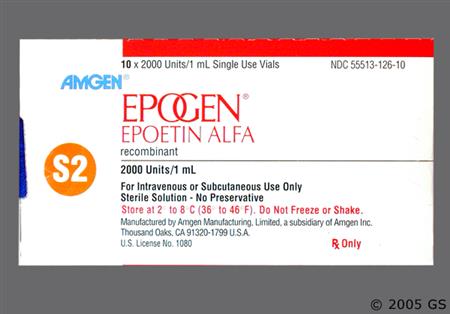
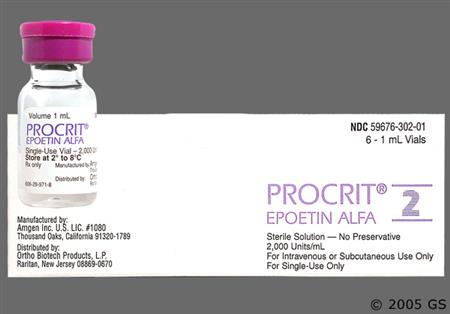
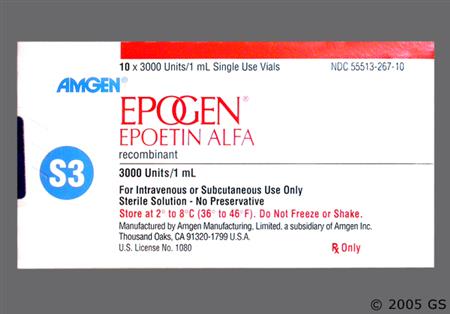
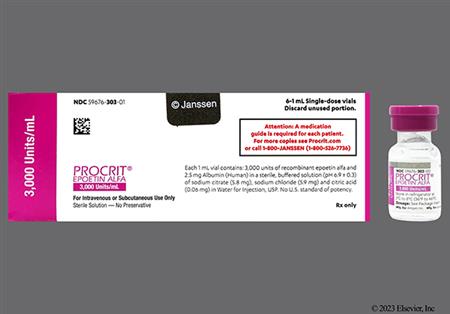
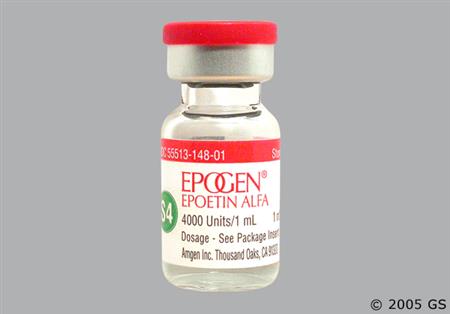
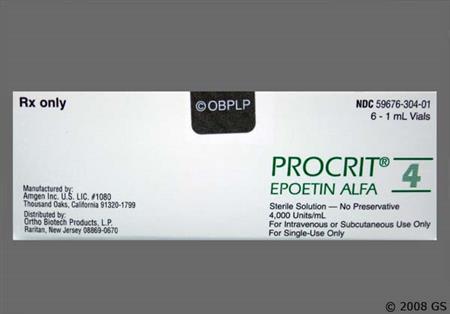
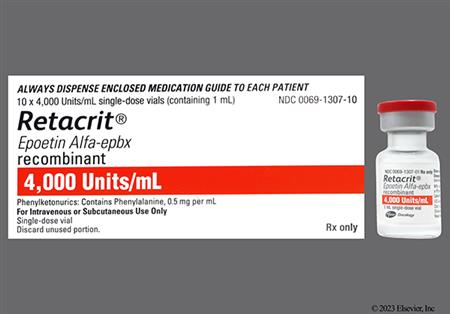
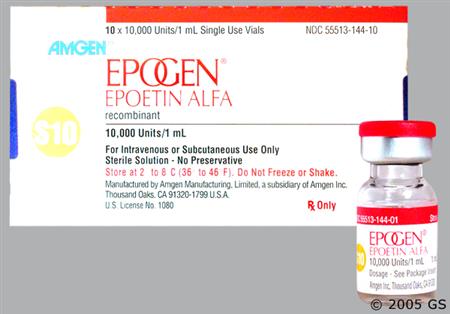
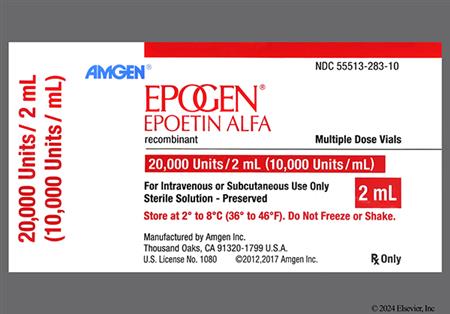
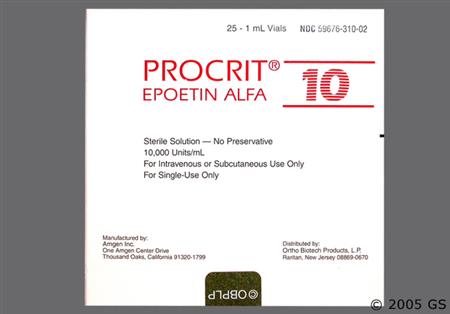

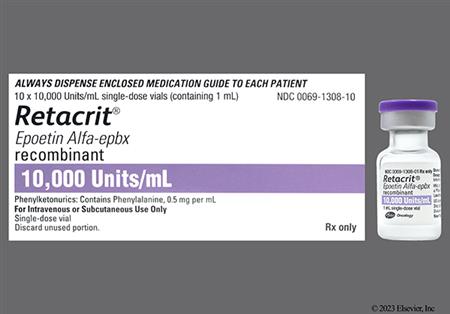
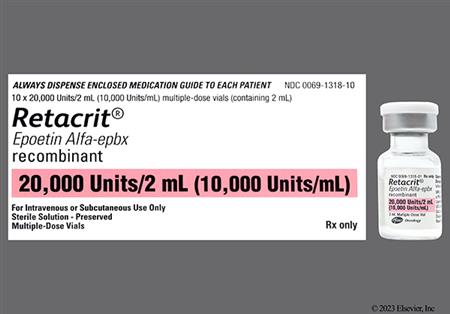
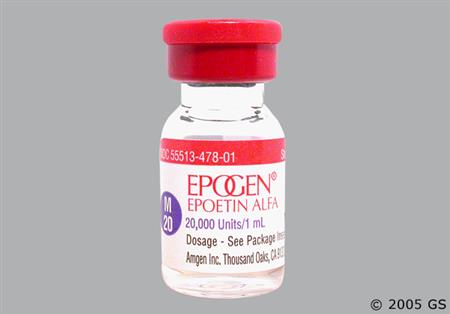
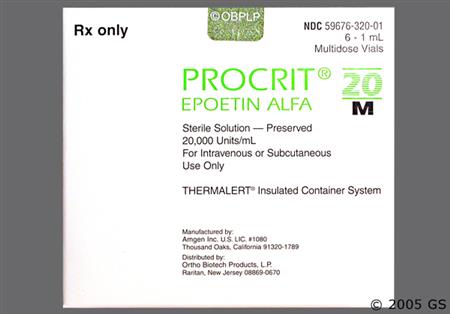
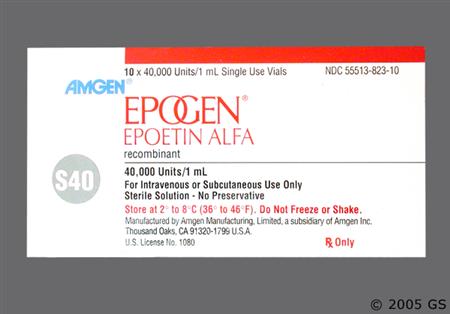
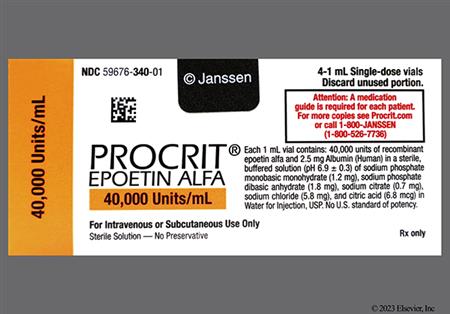
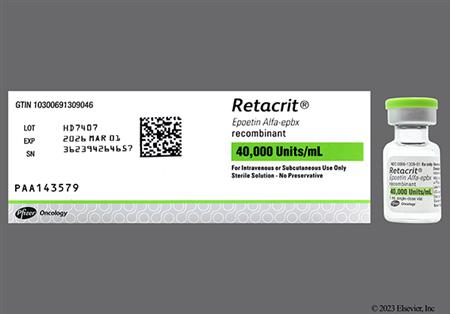
Epoetin alfa (r-HuEPO) is a recombinant form of the renal hormone erythropoietin (EPO) and belongs to a class of drugs known as erythropoiesis-stimulating agents (ESAs). Native EPO is a glycosylated protein with a molecular weight of about 36,000 daltons. Epoetin alfa is produced via recombinant technology in a Chinese hamster ovarian cell system. It is immunologically and biologically indistinguishable from native EPO, and its structure is very similar to the native protein with a molecular weight of 30,400 daltons. The composition and number of carbohydrate chains on epoetin alfa are comparable to those found on the native protein. Epoetin alfa is FDA-approved for the treatment of anemia due to chronic kidney disease, zidovudine therapy in HIV patients, and chemotherapy in patients with non-myeloid malignancies and to reduce the need for allogeneic blood transfusions in surgical patients. ESAs have been shown to increase the risk of death, myocardial infarction, stroke, venous thromboembolism, thrombosis of vascular access, and tumor progression or recurrence. Clinicians are advised to use the lowest dose that will gradually increase the hemoglobin concentration to the lowest hemoglobin sufficient to avoid the need for red blood cell transfusions.[30100][63174]
For storage information, see the specific product information within the How Supplied section.
Intermittent IV Infusion
Patients receiving epoetin alfa have developed hypertension, often within the first several months of therapy. Most commonly, hypertension occurs in adult patients with chronic renal failure receiving dialysis (27.7%), but it has also been reported in other patient populations including chronic renal failure patients not receiving dialysis (13.7%) and surgical patients (3% to 6%). Of note, after initiation and titration of epoetin alfa, approximately 25% of adult patients on dialysis required initiation of or increases in antihypertensive therapy.[30100] [63174] Hypertension has been associated with the acute increase in hematocrit during therapy, but other factors are involved. A significant increase in blood pressure has been inversely related to the pretreatment hematocrit concentration, but not the epoetin alfa dose or baseline blood pressure. Studies have suggested that hypertension may result from a reversal in anemic hypoxic peripheral vasodilation that occurs with improving cardiac output. Increases in blood viscosity have been suggested to play a role, but no significant difference in blood viscosity has been noted in hypertensive vs. normotensive patients. Patients with preexisting hypertension may require an increase in antihypertensive therapy. Take special care to closely monitor and aggressively control blood pressure. Advise patients regarding the importance of compliance with antihypertensive therapy and dietary restrictions. If blood pressure is difficult to control by initiation of appropriate measures, hemoglobin may be reduced by decreasing or withholding the dose of epoetin alfa. A clinically significant decrease in hemoglobin may not be observed for several weeks.[30100]
Hypertensive encephalopathy and seizures have been observed in adult patients with chronic renal failure treated with epoetin alfa. A sudden rise in blood pressure, associated with increased hematocrit, is believed to be the mechanism for seizures. Monitor hemoglobin weekly after treatment initiation and after each dosage adjustment, until the hemoglobin concentration is stable. Reduce the dose of epoetin alfa if the increase in hemoglobin exceeds 1 g/dL in any 2-week period, because of the possible association of excessive rate of rise of hemoglobin with an exacerbation of hypertension. Headache was reported during clinical trials for adult cancer patients (5% vs. 4% placebo) and in adult surgery patients (10% to 18% vs. 9% placebo). Dizziness was reported during adult trials of patients with chronic renal failure on dialysis (9.5% vs. 8.3% placebo). In trials conducted in patients with cancer, insomnia (6% vs. 2% placebo) and depression (5% vs. 4%) were reported.[30100] [45862] [63174]
As with all therapeutic proteins, there is a potential for immunogenicity. The presence of neutralizing antibodies (i.e., anti-erythropoietin antibodies) has been associated with the development of pure red cell aplasia (PRCA) in patients receiving recombinant erythropoietin products.[27008] [27009] Evaluate any patient experiencing a loss of response to epoetin alfa to determine the etiology of the loss of effect. Discontinue epoetin alfa in any patient with evidence of PRCA, and evaluate the patient for the presence of binding and neutralizing antibodies to epoetin alfa, native erythropoietin, and any other recombinant erythropoietin administered to the patient. Contact the manufacturer to perform assays for binding and neutralizing antibodies. Neutralizing antibodies to erythropoietin, in association with PRCA or severe anemia (with or without other cytopenias), have been reported in patients receiving epoetin.[30100] [45862] [63174] For the period of July 1997 through December 2001, 82 cases of PRCA after administration of epoetin alfa were reported to the FDA MedWatch program. Four patients received Epogen, none received Procrit, and 78 received Eprex, a product that is only distributed outside the US. The median age of patients with PRCA was 61 years, and 66% were men. The median duration of treatment with epoetin alfa to the time to diagnosis was 7 months (range: 1 month to 5 years). All patients received epoetin alfa for anemia associated with chronic renal failure.[27010] PRCA also has been reported in patients receiving erythropoiesis-stimulating agents undergoing treatment for hepatitis C with interferon and ribavirin. The incidence of antibody formation is highly dependent on the sensitivity and specificity of the assay. Comparison of the incidence of antibodies across products within this class (erythropoietic proteins) may be misleading.[30100] [45862] [63174]
Erythropoiesis-stimulating agents (ESAs) may increase the risk of death, cardiovascular adverse events including thromboembolism, and tumor progression or recurrence (in individuals with cancer). Among subjects with CKD, those who received an ESA to target a hemoglobin concentration of 13 to 14 g/dL had greater risks for death, myocardial infarction (MI), stroke, congestive heart failure, thrombosis of hemodialysis vascular access, and other thromboembolic events as compared with the subjects who had a hemoglobin target of 9 to 11.3 g/dL. In a trial of epoetin alfa in adult hemodialysis subjects with cardiac disease, mortality was increased in the group randomized to a target hemoglobin of 14 g/dL vs. 10 g/dL. The incidence of nonfatal myocardial infarction, vascular access thrombosis, and other thrombotic effects was also higher in the group randomized to achieve a hemoglobin of 14 g/dL. During hemodialysis, individuals treated with epoetin alfa may require increased anticoagulant therapy with heparin to prevent clotting of the dialysis machine.[30100] [45862] [63174] Furthermore, in a study of adults with renal impairment defined as chronic kidney disease not requiring renal replacement therapy (CrCl of 15 to 50 mL/minute/1.73 m2 of body surface area using the MDRD formula), a goal hemoglobin concentration of 13.5 g/dL (12.6 g/dL was the average concentration achieved during the study) vs. 11.3 g/dL was associated with an increased incidence of death, myocardial infarction, hospitalization for congestive heart failure without renal replacement therapy, and stroke.[32872] In individuals with cancer, multiple clinical trials have shown negative survival and disease control outcomes in subjects receiving ESAs. Among individuals receiving chemotherapy alone for their disease, clinical trials conducted in subjects with breast cancer (early and metastatic), cervical cancer, and lymphoid malignancies showed decreases in locoregional control, progression-free survival, and overall survival. In individuals receiving radiation therapy alone, trials conducted in subjects with head and neck cancer revealed decreases in locoregional control, 5-year locoregional progression-free survival, and overall survival. In individuals not actively receiving treatment for their cancer, trials conducted in subjects with non-small cell lung cancer and non-myeloid malignancies showed decreases in overall survival.[30100] [45862] [63174]
In a trial of epoetin alfa in adult hemodialysis patients with cardiac disease randomized to achieve a hemoglobin of 14 g/dL vs. 10 g/dL, the incidence of vascular access thrombosis and all other thrombotic events was higher in the group randomized to achieve a hemoglobin of 14 g/dL. In patients receiving an ESA, but not prophylactic anticoagulation, prior to surgical procedures in an effort to minimize the risk of allogeneic RBC transfusion, an increased incidence of venous thromboembolism has been noted in patients undergoing spinal surgery (deep venous thrombosis, DVT, incidence of 4.7% in patients receiving epoetin alfa vs. 2.1% in placebo). The incidence of DVT was 3% to 6% in patients undergoing major orthopedic surgery administered epoetin alfa compared to 3% in patients who received placebo. In patients receiving epoetin alfa to reduce the necessity of allogeneic RBC transfusion, antithrombotic prophylaxis is recommended. In zidovudine-treated persons living with HIV, pulmonary embolism occurred in 1% of patients receiving epoetin alfa. Increased mortality has been demonstrated in patients receiving epoetin alfa prior to CABG surgery; the deaths were associated with a thromboembolic/vascular event. Due to the effects on erythropoiesis, abuse of epoetin alfa may be seen in athletes. Misuse of medications that increase erythropoiesis, such as epoetin alfa, by healthy persons may lead to life-threatening cardiovascular complications (e.g., stroke, myocardial infarction, and thromboembolism).[30100] [45862] [63174] Illicit use of recombinant erythropoietin products by athletes, particularly cyclists, has led to a number of cases of sudden death. In these athletes, epoetin alfa caused a significant increase in hemoglobin concentrations that when exacerbated by dehydration during heavy exertion led to fatal thromboembolism. In addition, a systematic review of trials in patients with cancer (+/- chemotherapy) receiving ESAs vs. placebo or standard of care found a significantly increased risk of thromboembolic events in patients receiving an ESA (RR 1.57, 95% CI 1.31 to 1.87) and a non-significant increase in mortality risk (RR 1.1, 95% CI 1.01 to 1.2).[30100] [33816] [63174]
An injection site reaction, described as irritation (7% vs. 4% placebo) and pain (9% to 13% vs. 8% placebo), has been reported with epoetin alfa. Phlebitis and/or thrombophlebitis at the IV infusion site can be a problem during intravenous epoetin alfa therapy. Vascular occlusion (vascular access thrombosis) was reported in 8.1% (vs. 2.1% placebo) of patients with chronic kidney disease on dialysis. Additionally, medical device malfunction (artificial kidney clotting during dialysis) occurred in 8.1% (vs. 4.2%) of patients with chronic kidney disease on dialysis. Clotting problems are attributed to increased blood viscosity and a slight rise in platelet count, along with a decrease in bleeding time.[30100] [45862] [63174]
Flu-like symptoms can occur during epoetin alfa therapy. Arthralgia was reported more frequently in patients receiving the drug compared to placebo (chronic kidney disease on dialysis 16.2% vs. 3.1%; chronic kidney disease not on dialysis 12.2% vs. 7.6%; and cancer 10% vs. 6%). Muscle spasm was reported in 7.4% (vs. 6.3%) of patients with chronic kidney disease on dialysis. Fever (pyrexia) was reported in patients with chronic kidney disease on dialysis (10.1% vs. 8.3%) and in zidovudine-treated HIV-infected patients (42% vs. 34%). Chills were reported in surgery patients (4% to 7% vs. 1%). Myalgia (10% vs. 5%) and bone pain (7% vs. 4%) were reported in cancer patients receiving epoetin alfa.[30100] [45862] [63174]
In cancer and surgery patients receiving epoetin alfa, nausea has been reported at rates of 35% to 56% (vs. 30% to 45% for placebo) and vomiting at rates of 12% to 28% (vs. 14% to 16%). Stomatitis (10% vs. 8%), weight loss (9% vs. 5%), and dysphagia (5% vs. 2%) were also reported in cancer patients receiving epoetin alfa.[30100] [45862] [63174]
Skin rash has been reported during epoetin alfa treatment in cancer patients (7% vs. 5% placebo) and surgery patients (2% to 3% vs. 1%). Pruritus was also reported in surgery patients (12% to 21% vs. 14%). Erythema (0.8% vs. 0%) was reported in patients with chronic kidney disease not on dialysis. In zidovudine-treated HIV-infected patients, skin rash (19% vs. 7%) and urticaria (3% vs. 1%) have been reported. Serious allergic reactions, including anaphylactoid reactions, angioedema, bronchospasm, skin rash, and urticaria may occur. In addition, blistering and skin exfoliation reactions including erythema multiforme, Stevens-Johnson syndrome, and toxic epidermal necrolysis have been reported. Discontinue epoetin alfa immediately if a severe cutaneous or allergic reaction is suspected and administer appropriate therapy. Do not re-initiate treatment in patients who experience serious allergic or anaphylactic reactions.[30100] [45862] [63174]
In placebo-controlled clinical trials, respiratory-related adverse reactions have been reported with epoetin alfa. Cough was reported with epoetin alfa in 4% to 9% of cancer or surgery subjects (vs. 0% to 7% placebo) and in 26% of zidovudine-treated people living with HIV (vs. 14%). Upper respiratory tract infection was reported with epoetin alfa in 6.8% of subjects with chronic kidney disease on dialysis (vs. 5.2%). Respiratory congestion was reported with epoetin alfa in 1% of zidovudine-treated people living with HIV.[30100] [45862] [63174] Additionally, certain formulations of epoetin alfa contain albumin, a derivative of human blood. Based on effective donor screening and product manufacturing processes, it carries an extremely remote risk for transmission of viral diseases. A theoretical risk for transmission of Creutzfeldt-Jakob disease (CJD) is also considered extremely remote. No cases of transmission of viral diseases or CJD have ever been identified for albumin.[30100] [45862]
During clinical trials of epoetin alfa in cancer patients, hypokalemia (5% vs. 3% placebo), hyperglycemia (6% vs. 4%), and leukopenia (8% vs. 7%) were reported. When epoetin alfa was used in surgery patients, edema occurred in 1% to 3% of patients compared to 2% of patients receiving placebo.[30100] [45862] [63174]
Porphyria has been reported with the postmarketing use of epoetin alfa.[30100] [45862] [63174]
Epoetin increases hemoglobin synthesis decreasing erythrocyte pyridoxine status and may lead to vitamin B6 deficiency. Coadministration of low dose or moderate dose vitamin B6 may be beneficial. Supervise closely and monitor regularly, especially in patients with renal impairment.[63388]
The coadministration of certain medications may lead to harm and require avoidance or therapy modification; review all drug interactions prior to concomitant use of other medications.
This medication is contraindicated in patients with a history of hypersensitivity to it or any of its components.
Epoetin alfa is contraindicated in individuals with pure red cell aplasia (PRCA) that begins after treatment with an erythropoietin protein medication. Cases of PRCA and severe anemia, with or without other cytopenias associated with neutralizing antibodies to erythropoietin, have been reported in individuals treated with epoetin alfa, predominantly in individuals with chronic kidney disease receiving an erythropoiesis-stimulating agent (ESA) by subcutaneous administration.[30100] [45862] [63174]
In controlled trials, subjects with chronic kidney disease experienced greater risks for mortality, serious adverse cardiovascular reactions, and stroke when administered erythropoiesis-stimulating agents (ESAs) to target a hemoglobin concentration greater than 11 g/dL. No trial has identified a hemoglobin target concentration, ESA dose, or dosing strategy that does not increase these risks. Use the lowest ESA dose sufficient to reduce the need for red blood cell transfusions. For individuals with chronic kidney disease either on or off dialysis, a hemoglobin less than 10 g/dL is advised before epoetin alfa initiation. In controlled clinical trials of subjects with chronic kidney disease comparing higher hemoglobin targets (13 to 14 g/dL) to lower targets (9 to 11.3 g/dL), ESAs increased the risk of death, myocardial infarction, stroke, congestive heart failure, thrombosis of vascular access, and other thromboembolism in the higher target groups. Using ESAs to target a hemoglobin concentration greater than 11 g/dL increases the risk of serious adverse cardiovascular reactions and has not been shown to provide additional benefit. Use ESAs with caution in individuals with coexistent cardiovascular disease and stroke. Individuals with chronic kidney disease and an insufficient hemoglobin response to ESA therapy may be at even greater risk for cardiovascular reactions and mortality than other populations. A rate of hemoglobin rise of greater than 1 g/dL over 2 weeks may contribute to these risks; a dose reduction is warranted. Additionally, ESAs increased the risk of death in subjects undergoing coronary artery bypass graft surgery (CABG) and the risk of deep venous thrombosis (DVT) in individuals undergoing orthopedic surgery in controlled clinical trials.[30100] [45862] [63174] However, guidelines suggest it is reasonable to use ESAs with iron supplementation several days before cardiac surgery to increase red cell mass in individuals who have preoperative anemia, refuse blood cell transfusion, or are deemed high-risk for postoperative anemia; studies have reported no adverse effects associated with short-term ESA pretreatment.[66828] Due to increased risk of DVT, prophylaxis is strongly recommended when ESAs are used for the reduction of allogeneic red blood cell transfusions in surgical patients.[30100] [45862] [63174]
Epoetin alfa is contraindicated in individuals with uncontrolled hypertension; control hypertension before and during epoetin alfa therapy in all individuals. Advise individuals about the importance of compliance with antihypertensive therapy and dietary restriction.[30100] [45862] [63174]
Use of erythropoiesis stimulating agents (ESAs) shortened overall survival and/or increased the risk of tumor progression or recurrence in clinical studies of subjects with breast, non-small cell lung, head and neck, lymphoid, and cervical cancers. ESAs are not indicated for individuals receiving myelosuppressive chemotherapy when the anticipated outcome is cure. Further, use ESAs only for anemia from myelosuppressive chemotherapy, and use the lowest dose to avoid red blood cell transfusions. Discontinue the ESA after the completion of a chemotherapy course.[30100] [45862] [63174]
Advise individuals with a history of seizure disorder to contact their health care provider for premonitory symptoms or a change in seizure frequency. Epoetin alfa increases the risk of seizures in individuals with chronic kidney disease. During the first several months after epoetin alfa initiation, closely monitor for premonitory neurologic symptoms.[30100] [45862] [63174]
Epoetin alfa-epbx contains phenylalanine, a component of aspartame. Phenylalanine can be harmful to individuals with phenylketonuria. In individuals with phenylketonuria, consider the combined daily amount of phenylalanine from all sources if using epoetin alfa-epbx.[63174]
Use only the single-dose vials of epoetin alfa in neonates and infants. The multidose vials of epoetin alfa contain benzyl alcohol and are contraindicated in neonates and infants. Do not mix the single-dose vial with bacteriostatic saline, which also contains benzyl alcohol, when administering epoetin alfa to these populations. Serious and fatal reactions including 'gasping syndrome' can occur in neonates and infants treated with benzyl alcohol-preserved medications, including epoetin alfa multiple-dose vials. The minimum amount of benzyl alcohol necessary to cause toxicity is unknown.[30100] [45862] [63174]
Multidose vials of epoetin alfa are contraindicated during pregnancy due to the use of benzyl alcohol as a preservative. When epoetin alfa therapy is needed during pregnancy, use a single-dose vial, which is benzyl alcohol-free. Consider the benefits and risks of epoetin alfa single-dose vials for the mother and possible risks to the fetus when prescribing epoetin alfa to a pregnant woman. The limited available data on epoetin alfa use in pregnant women are insufficient to determine a drug-associated risk of adverse developmental outcomes. There are reports of intrauterine growth restriction and polyhydramnios in women with chronic renal disease, which is associated with an increased risk for these adverse pregnancy outcomes. In animal reproductive and developmental toxicity studies, embryofetal death, skeletal anomalies, and growth defects occurred when pregnant rats received epoetin alfa at doses approximating the clinical recommended starting doses.[30100] [45862] [63174]
Multidose vials of epoetin alfa are contraindicated in breast-feeding due to the use of benzyl alcohol as a preservative. Advise breast-feeding women to not breast-feed for at least 2 weeks after the last dose of epoetin alfa, if a multidose vial was used. Do not mix epoetin alfa with bacteriostatic saline containing benzyl alcohol. Use caution when administering epoetin alfa from a single-dose vial to a breast-feeding woman. There is no information regarding the presence of epoetin alfa in human milk, the effects on the breast-fed infant, or the effects on milk production. Endogenous erythropoietin is present in human milk.[30100] [45862] [63174]
Erythropoietin (EPO) is a glycoprotein that regulates the production of red blood cells by stimulating the division and differentiation of committed erythroid progenitor cells in the bone marrow. Epoetin alfa has the same biological activity as native EPO. In adults, almost 90% of EPO is produced in the kidney with the remainder produced by the liver. During fetal development, EPO is produced in the liver, and prior to birth at term, production is transferred to the kidney. Erythropoietin production in the kidney occurs in interstitial cells in the inner cortex that are in immediate proximity to the proximal tubules. More cells are activated as the hematocrit drops. Renal tubular cells may serve as oxygen sensors transmitting signals to the interstitial cells, possibly because they contain large amounts of heme protein that may function as an intracellular oxygen sensor and transducer.[23683]
Erythropoietin is required for the transformation of the most mature erythroid progenitor cell, erythroid colony-forming unit (CFU-E), to a proerythroblast. In the absence of EPO, this transformation cannot occur and the CFU-E will die. Erythropoietin activates the synthesis of hemoglobin and other proteins found in normal erythroblasts. Erythropoietin also causes a shift of marrow reticulocytes into the circulation. Due to the length of time required for erythropoiesis, a clinically significant increase in hematocrit is usually not observed in less than 2 weeks and may take up to 6 weeks in some patients. Erythropoietin has little effect on early erythroid progenitor cells, erythroid burst-forming units (BFU-E), whose growth is more dependent upon interleukin-3 and granulocyte-macrophage colony stimulating factor (GM-CSF). The production and activity of EPO is linked in a negative feedback loop, which maintains optimal red cell mass for oxygen transport. There appears to be a plateau of optimal oxygen transport to tissues occurring around hematocrits of 35% to 55% with significant decreases in oxygen transport above and below these values. Epoetin alfa produces a dose-dependent increase in the hematocrit; an increase of 2% per week may be seen during the initial phase of therapy. The stimulation of erythropoiesis increases the demand for iron, making iron supplementation necessary for many patients.[30100]
Revision Date: 10/03/2025, 09:15:54 AMEpoetin alfa is administered intravenously or subcutaneously. A dose-dependent response is seen with epoetin alfa doses of 50 to 300 units/kg 3 times a week; however, a greater response is not seen at doses more than 300 units/kg 3 times a week. Other factors affecting response to therapy include iron stores, baseline hematocrit, and concurrent medical conditions. As with the endogenous erythropoietin (EPO), epoetin alfa does not appear extravascularly in humans. Whether the drug crosses the placenta or is distributed into breast milk has not been evaluated. Metabolism and elimination of endogenous EPO or epoetin alfa are not fully understood. While the glycosylation of EPO does not affect its binding to target cells, it plays an important role in preventing the rapid clearance of the hormone from the bloodstream. Non-glycosylated erythropoietin has a half-life in vivo of a few minutes. About 10% of the dose appears to be excreted in the urine. In healthy volunteers, the half-life of epoetin alfa is approximately 20% shorter than the half-life in patients with chronic renal failure.[30100]
Affected cytochrome P450 isoenzymes and drug transporters: none
Administering epoetin alfa by the IV route results in a more rapid peak; however, the delayed systemic absorption from the subcutaneous route gives a more sustained response.[30100]
The subcutaneous route of administration produces peak plasma concentrations between 5 to 24 hours after the dose. Although the IV route gives a more rapid peak, the delayed systemic absorption from the subcutaneous route gives a more sustained response. Subcutaneous administration can result in some drug accumulation because of delayed absorption.[30100][63174]
Epoetin alfa half-life in patients with chronic renal failure after IV administration is 4 to 13 hours. The drug is not removed by hemodialysis.[30100][63174]
Children and Adolescents
The pharmacokinetic profile of epoetin alfa in children and adolescents appears to be similar to that of adults.[30100][63174]
Premature neonates
Relative to data obtained in 10 healthy adults, a study of 7 very low birthweight neonates given IV erythropoietin suggests that the volume of distribution and clearance are higher (1.5 to 2-fold and 3-fold, respectively) in premature neonates.[30100][63174] In a pharmacokinetic study performed in 40 preterm neonates (weight 750 grams to 1.25 kg; younger than 72 hours of age), patients were randomly assigned to receive epoetin alpha 200 units/kg/day subcutaneously or it was added to their TPN fluids daily. In the neonates who received epoetin alpha subcutaneously, the elimination half-life was 17.6 +/- 4.4 hours on day 3 and 11.2 +/-1.5 hours on day 10; the volume of distribution was 802 +/- 190 mL/kg on day 3 and 1,330 +/- 243 mL/kg on day 10. For both groups, serum epoetin concentrations were higher on day 3 than on day 10 (subcutaneous: 400 +/- 64 milliunits/mL vs. 177 +/- 29 milliunits/mL; TPN: 395 +/- 64 vs. 194 +/- 41 milliunits/mL). Clearance did not differ between the 2 groups with regard to route of administration and increased significantly from days 3 to 10 in both groups (subcutaneous: 35 +/- 5 mL/kg/hour at day 3 and 87 +/- 16 mL/kg/hour at day 7; TPN: 26 +/- 4 mL/kg/hour at day 3 and 65 +/- 20 mL/kg/hour at day 7).[53081]
In a prospective, dose-escalation, open-label trial, 60 premature neonates (younger than 24 hours old; weighing 1 kg or less; 28 weeks gestational age or younger) were treated with either high-dose recombinant erythropoietin or a control. Each neonate received 3 intravenous doses of 500, 1,000, or 2,500 units/kg at 24-hour intervals beginning on day 1 of age. The relationship between AUC and dosage was nonlinear. Epoetin alfa exhibited nonlinear pharmacokinetics since clearance decreased with increasing dosage (17.3 mL/kg/hour for 500 units/kg) to the highest dosage (8.2 mL/kg/hour for 2,500 units/kg). The mean AUC ratios were 2.6 for the 1,000 units/kg and 500 units/kg dosages and 10.1 for the 2,500 units/kg and 500 unit/kg dosages. Distribution volumes did not change as dosage increased. Steady-state plasma epoetin alpha concentrations were attained by the second dose for all 3 dosages. Both 1,000 and 2,500 units/kg recombinant erythropoietin produced peak serum erythropoietin concentrations that were comparable to neuroprotective concentrations previously seen in experimental animals.[53082]
Multidose vials of epoetin alfa are contraindicated during pregnancy due to the use of benzyl alcohol as a preservative. When epoetin alfa therapy is needed during pregnancy, use a single-dose vial, which is benzyl alcohol-free. Consider the benefits and risks of epoetin alfa single-dose vials for the mother and possible risks to the fetus when prescribing epoetin alfa to a pregnant woman. The limited available data on epoetin alfa use in pregnant women are insufficient to determine a drug-associated risk of adverse developmental outcomes. There are reports of intrauterine growth restriction and polyhydramnios in women with chronic renal disease, which is associated with an increased risk for these adverse pregnancy outcomes. In animal reproductive and developmental toxicity studies, embryofetal death, skeletal anomalies, and growth defects occurred when pregnant rats received epoetin alfa at doses approximating the clinical recommended starting doses.[30100] [45862] [63174]
Multidose vials of epoetin alfa are contraindicated in breast-feeding due to the use of benzyl alcohol as a preservative. Advise breast-feeding women to not breast-feed for at least 2 weeks after the last dose of epoetin alfa, if a multidose vial was used. Do not mix epoetin alfa with bacteriostatic saline containing benzyl alcohol. Use caution when administering epoetin alfa from a single-dose vial to a breast-feeding woman. There is no information regarding the presence of epoetin alfa in human milk, the effects on the breast-fed infant, or the effects on milk production. Endogenous erythropoietin is present in human milk.[30100] [45862] [63174]
Cookies are used by this site. To decline or learn more, visit our cookie notice.
Copyright © 2025 Elsevier, its licensors, and contributors. All rights are reserved, including those for text and data mining, AI training, and similar technologies.